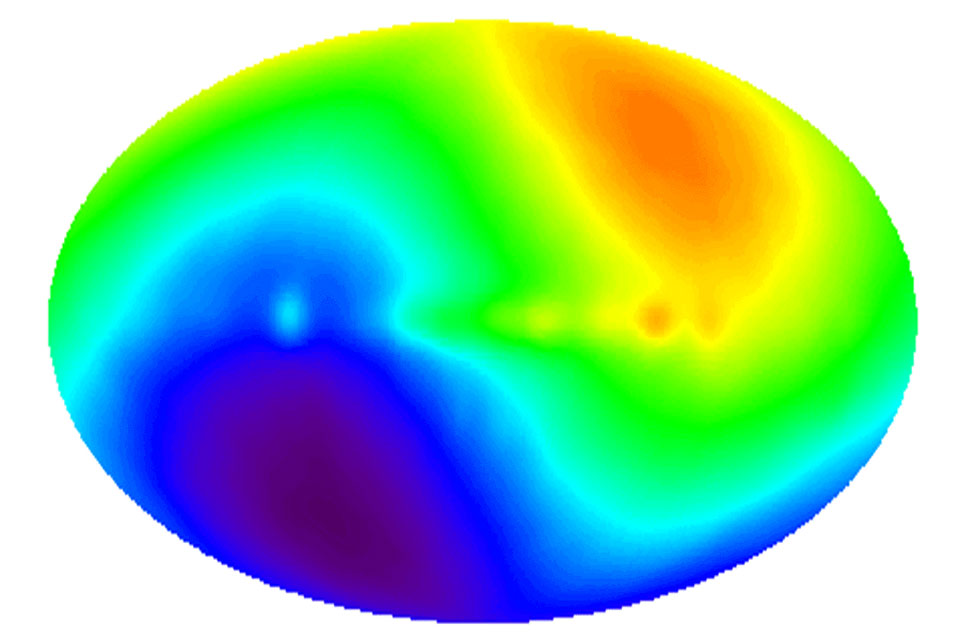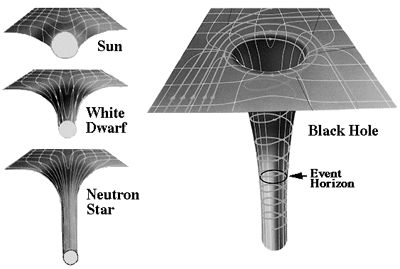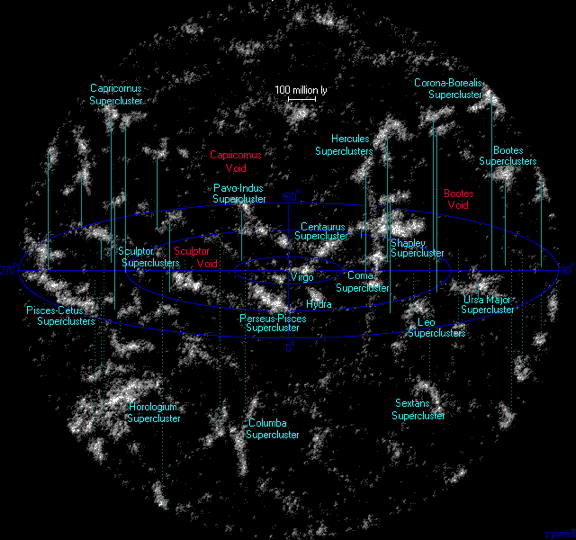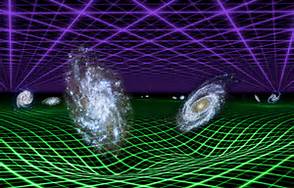Einstein's General Relativity (GR), published in 1916, has had a good run for almost a century as the proclaimed ultimate theory of gravity. However, GR is only a good mathematical description of a still unknown force of gravity, within limited dimensions, involving so-called spacetime indentations.
On the other hand, Graviton Gravity (GG) can be shown to continuously work within all dimensions as well as in large dimensions where GR gravity does not. At intermediate regions between our Milky Way (MW) and the Cosmic Microwave Background (CMB) we find strong scientific evidence for a superior paradigm.
General Relativity has multiple problems with its model of gravity:
(1) Classical GR does not hold up within the ultra-small Planck dimension, and therefore can never be a theory of everything.
(2) Space-time indentations can be shown to be mathematical descriptions of Graviton Gravity's "low-pressure-zone, blocking curves."
(3) Outside the spacetime dimples, space very quickly loses its slopes and returns to a level "surface." The absence of gravity slopes beyond the dimples makes spacetime gravity discontinuous within certain dimensions.
(4) Einstein had to tinker with his GR math to keep his ideally steady-state universe from later imploding in a big crunch. He inserted a fudge factor into the GR formula, the "lambda" letter.
(5) Lambda has more recently turned into GR's idea of Dark Energy, by simply increasing universal lambda in the formula. Dark Energy does not appreciably kick in within a couple billion light years from us. It is characterized by a symmetrical outward pressure, equal toward all directions, with accelerating force.
(6) Satellite data from our movement relative to an area of the Cosmic Microwave Background (CMB) shows that we are moving 600 kilometers per second toward an area in the Norma-to-Centaurus clusters, and retreating from the opposite direction. GR has no explanation for that asymmetrical accelerating vector, as space-time slope vectors cannot extend out that far from each other. However, GG does clearly and coherently explain this motion.
(7) The idea of Dark Energy within General Relativity is an artifact to hide GR's inability to describe what is really going on. Likewise, Dark Matter is unknown, except that it somehow shares gravity and spacetime with baryonic matter. In contrast, the GG model coherently and elegantly explains both phenomena as to what they are and how they work.
General Relativity formulas describe Graviton Gravity at and near large individual masses, such as planets and stars, or clusters of galaxies. The key here is "at and near" spacetime dimples in GR's fancy spacetime ether.
GR, in asserting the geometry of gravity, does a poor job describing how the implied tractor-beam nature of gravity works, an idea inherited from Newton, although that term is from the 20th century. Newton lived in a cozy 17th century universe. He incorrectly assumed that the Earth instantly attracts us to it. Newton's tidy 3D inertial frame had no distance limits on his idea of gravity, a concept that falls short in today's vast four-dimensional spaces, where gravitons move no faster than photons.
So, we have in GR a calculus that works well in some dimensions, and not in others. It relies on hypothetical membranes, ignores quantum mechanics in the Planck dimension, and hasn't a clue about Dark Energy and Dark Matter. GR is hardly a viable candidate for a theory of everything.
I have access through my home computer, by way of my astronomy software (Equinox Pro), to various Digital Sky Survey (DSS) image sources. Comparing similar images with red and blue filters, one can see how the relative color/brightness of galaxies within and without the "graviton-blocking train" differ. Blue filters enhance a Doppler effect of increasing/approaching frequency. Red filters in an increasing-frequency environment give a dimmer image field, that otherwise would be brighter for receding galaxies experiencing a Dark Energy red shift.
The blue filtered images below are brighter than the red filtered images along the great gravity blocking vector, indicating that their visual appearance shifts somewhat toward the Doppler blue. Both blue and red filters are looking at the same clustered galaxies from 250 to 650 million light years away. What does this mean?
According to satellite data of our speed relative to specific areas of the Cosmic Microwave Background (CMB), there is a blue shift in the train of clusters and superclusters extending from our Local Group toward the distant Shapley clusters. There is also an area of blueness toward what has been called the Great Attractor, which is the less distant area of the Norma supercluster. The Norma area galaxies lie behind the plane of the MW, and cannot be well seen by amateur observers. Both graviton blocking regions are sufficiently near each other in our skies to jointly direct us toward one area of the CMB.
Although the Shapley region has been well studied, the Norma region has been somewhat hidden from our eyes behind galactic dust. Also, only recently has it been calculated that the graviton blocking force of this Norma region has about ten times as much Dark Matter as the baryonic matter we can detect.
The Norma supercluster, a.k.a. The Great Attractor, is situated near NGC 6025, a foreground open cluster. It is also known as Abell 3627. The Shapley supercluster is situated about three degrees south and southwest of Messier 83, and is generally around Abell 3558.
Interestingly, catalog data used to build the Atlas of the Universe does not indicate anything special in the Norma direction. This data doesn't detail "small" superclusters, such as our own Virgo supercluster. Obviously, the data available to this Atlas could not describe either coma-like accumulations of Dark Matter near galaxies; or the webs of Dark Matter that occupy the universe itself, and which help guide the linear association of galaxy clusters. It is likely that one of those webs is involved in the amazing string of galactic clusters from our galaxy out 650 million light years toward the distant Shapley superclusters.
There is a way you might see this phenomenon for yourself using your home computer, an Internet connection, and access to both blue-filtered and red-filtered images from the Digital Sky Survey's POSS2/UKSTV ground-based telescope. I use a software program that gives me built-in access to multiple DSS telescopes.
However, no ground-based telescope can match the sensitivity of a specialized space telescope.
With these cautions in mind, try these two things:
(1) The Shapley Supercluster, "b" region, lies 650 million light years (mly) away at the distant area of our graviton blocking train. A major group therein is the Abell supercluster galaxy catalog object 3558 (A3558). You can go to the POSS2/UKSTV red and blue images for RA 13h 28m 44s, and DEC -31deg. 34m 1.1". I use a field of view (FOV) about 15 minutes wide (half the width of our Moon), giving me about 250x.
This area is red-shifted 0.048z. At that distance we should ordinarily see some overall light shifting away from us toward the red side of our visual spectrum. That would be the Doppler train whistle getting lower. However, as we are riding that gravity blocking train faster to the cluster than the cluster is moving away from us toward the CMB, the observed light spectrum will be brighter with a blue filter than with a red filter. It's like the Doppler train whistle is getting higher pitched as the light spectrum blue shifts.
(2) Let's look at another supercluster over 70 degrees away in the sky, not along the "train's" line of motion. This one will be at roughly the same distance. Our choice is the Leo Supercluster. It is 440 mly away, and red shifted 0.032z. Its brightest area is A1185, located at RA 11h 11m 18s, and Dec +28deg. 38' 55.1". Set up a similar 15m FOV with POSS2/UKSTV, using red and blue filters.
Here the red-filtered view is brighter than the blue-filtered view, which is exactly what you would expect as overall "Dark Energy" gathers speed. Leo is not along our more powerful graviton blocking train; so graviton blocking force vectors in Leo's area of the sky are less, as we would expect overall.
We are not going to try this DSS comparison with the Norma cluster, because it is mostly hidden behind the dusty plane of the MW, and it takes special instruments to properly observe. The 10x extra power of dark energy associated therein is a mathematical conclusion, based on our measured movement vs. the CMB in that direction.
The bottom line here is simple: There is a "train" of clusters and superclusters, including our own, moving in the Shapley direction. There is also movement toward the "Great Attractor" Norma direction. Together, these two graviton-blocking train vectors merge into a net blue-shift movement toward a region of the CMB which has been satellite measured at about 600 kilometers per second. But don't worry, at this current speed it would take about 4.75 trillion years for our local matter to get to the Great Attractor area, at which time none of the current galaxies will exist, nor would our universe in its current form.
What does General Relativity gravity have to say to explain our powerful graviton-blocking mass train? Nothing. Even dimples associated with great clusters of galaxies are too small and local to connect all elements of this virtual train at this great distance. There is too much level spacetime to connect and focus a train of galaxies over such a great distance. Even with multiple random spacetime dimples, the tractor-trailer gravity which hides below spacetime sheet dimples would have a random effect on it all.
In sharp contrast is the real force of gravity. It has eluded the brightest minds for centuries because it is too obvious. Try this: Stand in front of a large blank wall in a room. Put your nose one inch from the blank surface, and look straight ahead. What do you see? Only a blankness. Next, step back several feet. What can you see? The room and its walls. Graviton gravity is like that wall one inch from your nose. Always there, always unseen, until you shift your perspective.
Standing on the Earth we feel its pulling power, which we call gravity. It's a force felt like the infamous tractor beams controlling the Starship Enterprise, keeping its crew from moving away from the alien planet's rays. In the real world there are no tractor beams here or anywhere else. If tractor beams were universal, then our human bodies would also have weak tractor beams infinitely reaching out in all directions.
In a universe without tractor beams, what then holds us to the Earth or to any other massive body? What holds the Moon to Earth, and what power does the Sun have to hold together our Solar System?
Gravity is not a force of attraction. It is a vector of lesser repulsion, measured by net pressure gradients. As I have explained elsewhere, we are continually and uniformly bombarded by incredibly vast streams of gravitons from all directions. Because these streams are most likely coming from the multiverse, and are thus equal in power, they cancel out each other in their net repulsive force on our mass. In the absence of any blocking mass in the lines of force constituting the net force vectors, we won't move. It would be like floating in perfect space.
When two objects are next to each other they APPEAR to mutually attract. This illusion is a perfect expression of Newton's otherwise puzzling third law of motion. Each body, be it planet or person, will block or deflect some small portion of the stream of gravitons otherwise directly heading to and pushing on the adjacent massive body. This blocking effect, which is relative to the intervening mass of each body, creates a localized "low pressure" area between the two bodies.
In the case of man vs. Earth, the net apparent effect comes from the much more massive Earth. Nevertheless, the man is also blocking a tiny amount of gravitons, and therefore creates a tiny low-pressure attractive effect on the Earth, in the form of locally diminished net pressure vectors. These two vectors are equal in strength, and in opposite directions; and are perfect examples of Newton's third law of motion.
What works on the adjacent scale also works on mass and distance scales of the Norma and Shapley superclusters. They are blocking more straight-line graviton flows, all of which are following Newton's first law of motion, from their multiverse origins. The train of galaxies in which we find ourselves all combine to amplify the blocking effect of each mass on those directly "down stream."
Therefore, the observed blue-shift Doppler effects vis-a-vis the "train's" background CMB can be described by the net lower pressure effects over time that we call Graviton Gravity, and cannot as easily be described by General Relativity Gravity. Nor can the idea of Dark Energy help at these intermediate distances, because we are approaching this limited area of the sky with a Doppler blue shift faster than the overall red shift evidenced in the CMB.
The overall net flow of gravitons within and among the multiverse's universes accounts for the observed smooth Dark Energy expansion within our overall visible universe.
Within our intermediate zone inside the nearest billion light years, and along and behind our train of graviton blocking galaxies increasing proximity to these galaxies and their associated dark matter is the opposite of what generally is happening elsewhere in our universal bubble. This atypical and relatively local movement is easily explained within Graviton Gravity by the same net pressure gradients that explain our galaxy's outer mass movement toward greater universal masses far beyond the nearest 650 million light years.
The same net pressure vector gradients explanation works for gravity in any dimension, at any distance, which is what is needed for a successful theory of everything. This Graviton Theory of Everything fulfills all the requirements in an classically elegant way.



